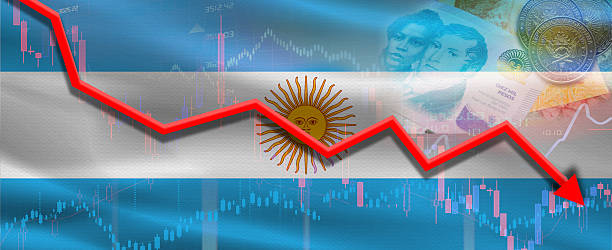The Argentine peso experienced its first meaningful decline in several days after the government shifted its approach to currency management. The peso opened trading on Thursday down approximately 2.7% against the United States dollar, reaching a level of 1,469 pesos per dollar before recovering some of those losses to trade down roughly 0.8% by midday in Buenos Aires. This depreciation marked a notable change in monetary policy following several consecutive trading sessions during which the government had maintained the currency at comparatively stable levels through aggressive dollar sales.
The decision to permit currency weakness appeared driven by two intersecting considerations. First, the intensive intervention required to support the peso at artificially elevated levels was depleting the country’s limited foreign exchange reserves at an unsustainable rate. Second, finalisation of discussions between Argentina’s Economy Minister Luis Caputo and United States Treasury Secretary Scott Bessent regarding American financial assistance created conditions under which the government could relax its immediate stabilisation efforts.
Market reaction to the currency movement revealed pronounced sensitivity to policy shifts. Argentine sovereign debt denominated in United States dollars rose substantially, with the nation’s 2035-maturity dollar bonds increasing by approximately 2.8 cents on the dollar to trade at 59 cents on the dollar. These bonds had previously experienced significant price volatility throughout the preceding month as investors attempted to assess the probability and timing of external support from Washington.
Central Bank and Treasury Department Incurred Substantial Foreign Exchange Losses
The operational burden of maintaining currency stability through direct intervention had become increasingly apparent in the preceding weeks. Argentina’s central bank exhausted approximately $1.1 billion of its foreign exchange reserves during the month of September through the purchase of pesos and sale of dollars designed to prevent depreciation. Simultaneously, the Treasury Department deployed an estimated $1.8 billion in dollar sales across the seven trading sessions preceding the Thursday decision to permit peso weakness.
The scale of these interventions relative to Argentina’s overall foreign exchange position underscored the severity of the currency crisis. The country maintained approximately $20 billion in liquid foreign exchange reserves, meaning that the central bank’s single month of intervention consumed roughly 5% of accessible reserves. This rate of reserve depletion created a mathematical trajectory that would have rendered continued intervention untenable within a matter of months.
The structural drivers underlying Argentina’s currency pressures extend beyond immediate market sentiment. The country confronts persistent fiscal deficits equivalent to approximately 5.4% of gross domestic product, creating a fundamental imbalance between government expenditure and revenue collection. The economy remains heavily dependent upon agricultural exports, with soybean sales representing roughly 24% of total export revenues. This concentration in commodity exports exposes the economy to significant volatility in international agricultural price movements.
Political Setbacks and Economic Deterioration Compounded Market Pressures on Peso
The underlying economic crisis had been exacerbated by political developments during September. President Javier Milei suffered a substantial electoral defeat during local voting in Buenos Aires province, a political stronghold where the administration had anticipated competitive results. The electoral setback reflected mounting public discontent regarding economic conditions and the performance of the president’s reform agenda.
Simultaneously, various corruption-related scandals involving figures close to the president further eroded confidence in the administration’s governance capacity. These political complications coincided with the advancement of economic difficulties, creating a compounding loss of confidence among both domestic residents and international investors.
Market participants demonstrated pronounced ambivalence regarding the outlook for Argentine stabilisation. Analysis from Walter Stoeppelwerth, Chief Investment Officer at Grit Capital Group, characterised the prevailing sentiment as exhibiting “hair-trigger” characteristics. Investors remained torn between concerns regarding the rate of reserve depletion and cautious optimism that American assistance might materialise imminently.
International Financial Support Offers Potential Near-Term Stabilisation
The anticipated provision of American financial assistance represented a significant development in addressing Argentina’s immediate liquidity position. Discussions between Argentine and American Treasury officials resulted in the finalisation of terms for a loan package estimated at $20 billion. The structure of this assistance involved collateralisation arrangements denominated in pesos, coupled with potential additional direct intervention by American authorities to purchase Argentine sovereign debt.
Such international support possessed meaningful but ultimately limited capacity to address the underlying structural dimensions of Argentina’s economic crisis. The country’s fiscal deficit, which had persisted through both the previous administration and the initial months of the Milei presidency, required fundamental reforms to taxation and government expenditure to resolve on a durable basis. The provision of external financing could bridge a temporary financing gap and avert an immediate liquidity crisis, but would not independently resolve the underlying fiscal imbalance.
International Monetary Fund Managing Director Kristalina Georgieva indicated in communications with news organisations that decisions regarding additional IMF support for Argentina remained imminent. The Fund had previously approved a loan programme for Argentina on 11 April 2025, representing the 23rd discrete IMF assistance programme extended to the country since 1958. This historical sequence of repeated intervention reflected the persistence of Argentine economic difficulties across multiple decades and political administrations.
Dollarisation Ambitions and Alternative Monetary Systems
The ongoing currency crisis has accelerated longstanding debates within Argentina regarding monetary arrangements and the appropriate structure of the financial system. President Milei has articulated support for the liberalisation of dollar usage within the Argentine economy, with the ultimate possibility of formal dollarisation replacing the peso entirely. Such a transition would represent a fundamental reorientation of monetary policy, transferring control over the monetary base from Argentine authorities to the American Federal Reserve.Coinciding with this dollarisation agenda, Argentina has experienced a substantial expansion in cryptocurrency adoption driven by persistent economic instability. Economic analysis indicates that Argentine residents and businesses have increasingly turned to bitcoin and stablecoin holdings as mechanisms to hedge against peso depreciation and preserve wealth against inflation. Over 50% of cryptocurrency purchasers in Argentina have explicitly identified inflation protection and preservation of purchasing power as primary motivations for digital asset adoption.


